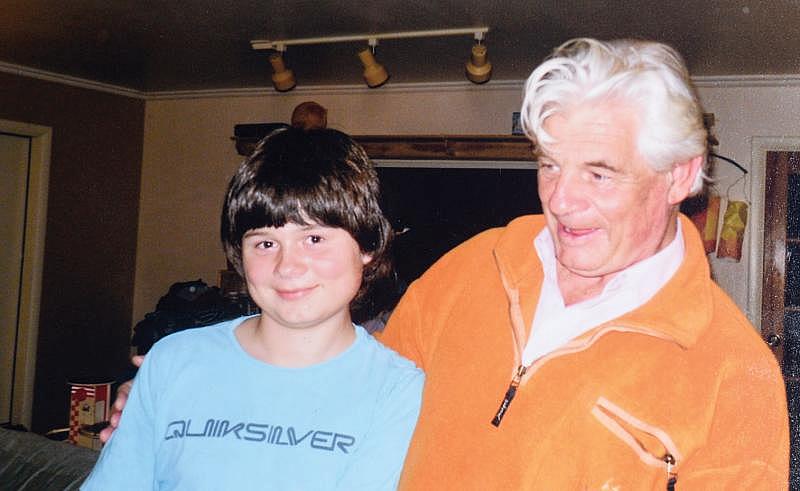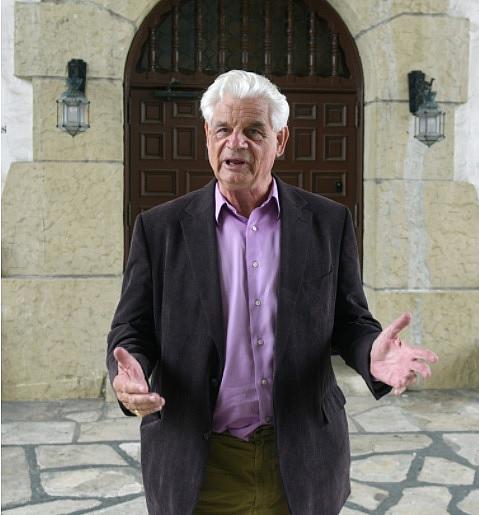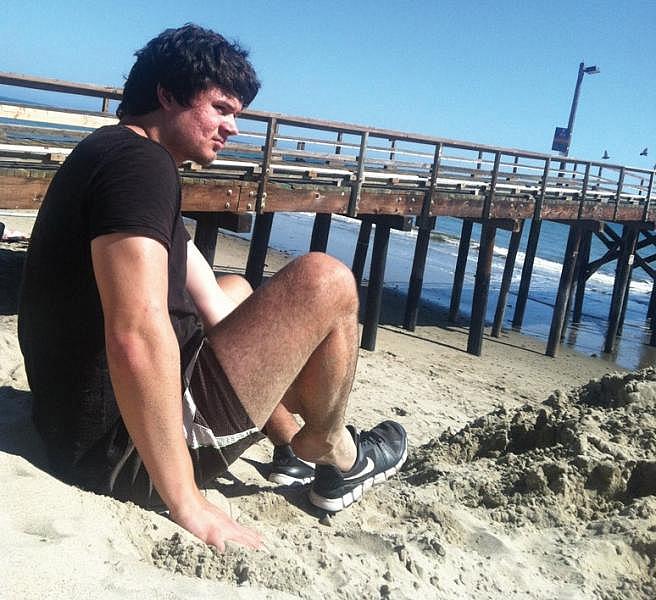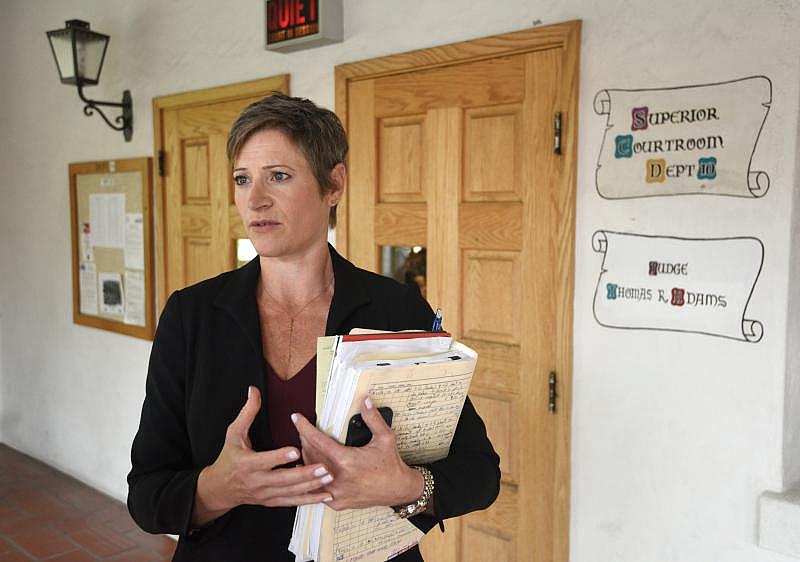Welcome to the Madhouse
This article was written as part of a Fellowship project with the USC-Annenberg Center for Health Care Journalism.

Pictured is Everest Hickey in less troubled days.
Everest Hickey is a sweet-natured, massively built man-child locked up in an acute-care psychiatric facility in Merced County. He’s there because he tried to choke his mother to death last June. At the time, he was 17 years old and in the throes of a psychotic episode. Everest — diagnosed with a variant of autism and schizophrenia — is now facing criminal prosecution in Santa Barbara County, where he grew up, for attempted murder.
For the moment, Everest is extremely happy to be where he is. “This is so much better than jail,” he said in a telephone interview. “Prison is hell. I’m sorry to use that word, ‘hell,’ but it is.” He should know; he spent the better part of five months locked up in Santa Barbara County’s Juvenile Hall, with about 63 teens, all facing criminal charges. But he was the only one charged as an adult.
Still, Everest will be much happier if he gets to stay where he is. It appears that will probably happen. But probably is cold comfort to him and his family, given the looming possibility of his adult sentence: 25 years to life.
There are complicated wrinkles that make Everest’s case exceptional. But for many families struggling to navigate the maze of available mental-health treatment, his story highlights the desperate lengths to which they must go to get needed help. The dearth of psychiatric bed space is just one of many shortcomings afflicting the nation’s mental-health delivery system — but it’s a big one. Last year, there were only around 37,000 psychiatric hospital beds in the whole country. Sixty years ago, there were nearly 560,000.
If his parents had been able to find space in a residential treatment facility before their son’s psychosis exploded, he would not be worrying about life behind bars. But last June, either those beds were occupied or Everest didn’t qualify. Before he could get the help that he needed, he would have to strangle his mother. And county prosecutors would have to throw the book at him. From the outside looking in, charging a mentally ill minor with attempted murder — as an adult — certainly appeared draconian. But prosecutors wanted to get him into a safe place. Because so few juvenile treatment options existed, this was the best strategy they could think of.
Because of that, Everest now resides in Merced County, a guest of California Psychiatric Transitions.
For the Hickey family, it’s been the road to hell and back. But given the other possible outcomes, this might qualify as a happy ending.
It’s not over yet, however.
The Dawning of Hell
Everest, the oldest of three sons, spent his first seven years in England. His mother, April Joy Hickey, is a self-described “Army-Navy brat” from the United States; his father, Patrick Hickey, is an English physician. As a toddler, Everest was quiet and engaged. He was quick to figure out jigsaw puzzles. He liked to ride bikes, swim, and play with friends. At age 7, he, his mother, and two brothers moved to Santa Barbara; Patrick would follow two years later. Everest attended the private Waldorf School, where he got along well. He played basketball. “He was just a really nice guy,” his mother said. “He was never mean; he was never violent; he never hit anybody.” By the time Everest was 11, however, it became apparent he had learning problems. By the time he was 13, those difficulties had grown more pronounced, and he started to withdraw. That withdrawal accelerated when Everest started at Santa Barbara High School. He stopped playing basketball. He stopped swimming. He spent more time alone. He watched zombie television shows and war movies. He played video games. He was frequently late to a third-period class because he had to climb stairs to get there. He wouldn’t begin to go up until there was no one going down. Physically, he became clumsy and began exhibiting traits consistent with autism, a diagnosis he would eventually receive.
Patrick Hickey (right) wants to take his son, Everest (left), to England, where the mentally ill are treated for their sickness, not criminally prosecuted.
By then, the Hickey marriage was fraught. It was the third for Patrick, an intense man of decided opinions, and by 2016, mom April — 20 years Patrick’s junior — had made it clear she wanted a divorce. Everest, especially close to his father, blamed his mother for breaking up the family. When longtime friends from out of town visited Santa Barbara in the summer of 2015, Everest shined them on. Only when his mother ordered him to join them did he agree to go to Zodo’s, a Goleta bowling alley. There, the stimulation of Zodo’s bright lights and ambient din seemed to be too much for Everest. Upon returning home, he shut himself in the bathroom, where his mother could hear him muttering, “Kill, kill, kill.” When he refused to come out, she called the police. They took Everest to Cottage Hospital for what would be the first of five trips to the emergency room.
From there, he was sent to Aurora Vista del Mar in Ventura, a psychiatric hospital licensed to accept minors. He would stay there for five days; it would be the first of three such visits. While there, he reportedly met just once with a psychiatrist, who issued a prescription for Celexa, commonly used to treat depression, anxiety, and panic.
A year later, late May 2016, the demons afflicting Everest went radioactive. Voices inside his head — he claimed it was God talking — ordered him to kill his mother and his two younger brothers. He told his mother his grim game plan. Terrified for her younger sons, and afraid for herself, April slept with a hammer next to her bed. She hid the knives. She sought help from the county’s Department of Behavioral Wellness, where Everest began seeing a psychiatrist named Dr. Fred Berge.
What Everest needed most urgently, however, was precisely what he could not get: long-term residential inpatient care. For a host of reasons, Everest did not qualify: He was too young, he was autistic, no beds were available, and his parents’ insurance wouldn’t cover the facility. So, instead, Berge and his team crafted an emergency treatment plan: Everest would stay at home, and they would bombard him with intensive outpatient therapy.
The voices in Everest’s head got louder, more insistent. They wouldn’t shut up. April took Everest back to the emergency room. He had a blister on his hand from digging a hole in the backyard where he intended to bury the family. This touched off a mad scramble to find a residential placement for him. Twenty-two institutions in California were contacted. None would — or could — accept him.
At 6'5'' and 250 pounds, Everest would seem way too big to slip through the cracks.

But that’s exactly what happened. He was 17, and the county’s only public psychiatric hospital — the Psychiatric Health Facility (PHF) — is not licensed to accept minors. Only one psychiatric hospital in all of California accepts juvenile patients with autism. It was full.
A Danger to Others
On June 11, Everest was admitted for the third time in three weeks to Cottage’s special emergency room adjunct created to deal with the growing number of patients arriving with acute psychological symptoms. He was placed on a 72-hour involuntary hold because county mental-health workers determined he was “DTO” — Danger to Others.
At the time, Patrick was in England on business matters, so April was alone and facing a nightmare choice. She was notified that if she did not have her first-born son declared a ward of the state, Child Protective Services might take her two other sons because Everest was too dangerous to be in the same house.
According to medical records, Dr. Berge and Cottage’s psychiatric staff argued a second involuntary hold was warranted. But, legally, county mental-health administrators had the final say, and they refused to authorize it. April pitched a fit. She said she would buy two Tasers and a vial of pepper spray — for self-defense. “My son’s a very sick person,” she remembered yelling. “This is a human-rights violation.”
Cottage’s ER and psychiatric medical team finally figured out how to keep Everest longer. One high-ranking Cottage executive, April said, urged her to hire an attorney. She was convinced her son’s medication was contributing to his violent urges and hallucinations. ER doctors discontinued the Celexa. On June 17, Everest was officially discharged. April drove him home. Tragically, he wouldn’t stay home long. On June 20 — just 69 hours after having been released from Cottage — Everest tried to kill his mother.
Obeying Orders
It had been a busy day. April and Everest had gone to the beach; they did chores. But Everest kept looking at his mother strangely, hovering behind her. “You felt something was going on,” she said. It was time, she decided, to check in with Everest’s psychiatrist. When they were about to get in the car, Everest approached her with his arms stretched out. “Mom, come here,” she remembered him saying. She thought he was going to hug her. Instead, he wrapped his hands around her throat. She couldn’t pry his thumbs off. She never thought of hitting back. Instead, she screamed, “Fire!” Somehow, she managed to get loose and run. But Everest tackled her. He started choking her again. At the time, her 14-year-old son had been swimming in the condo pool with two friends. Hearing the screams, they came running and dragged Everest off.
Patrick Hickey
Everest said he remembered “having this flash before my eyes about killing her.” He said he felt dizzy and jagged. “I had no control of myself,” he said. “I had to choke her to death. It wasn’t me. I was having this warm-blooded feeling. It was like I had a headache. I literally had to attack my mom to survive.”
Both April and Everest were taken to Cottage via separate ambulance. After four days there, Everest was sent to Aurora Vista del Mar. According to Everest’s mother, Cottage had to get a court order to force Vista del Mar to accept him. There, his psychosis reached solar-storm intensity. During his six-day stay, he banged against walls, stared into space, attacked a Vista employee, and attempted to strangle a 70-year-old female patient.
On June 30, Everest was take to Santa Barbara County’s Juvenile Hall in Santa Maria, where he spent the next four months. He was a minor. He had autism. There was no place else for him to go. On July 1, the District Attorney’s office charged him with attempted murder — as an adult.
Patrick, Everest’s father, soon returned to Santa Barbara and devoted all his considerable energy to his son’s defense. A medical doctor by profession, the elder Hickey — 72 years old — quickly became a veritable fire hose of outrage. Though he took pains to praise the “kindness, consideration, and care” his son received at Juvenile Hall, he was incredulous that Everest was in any lockup at all. “This is not a hospital,” he stormed. “This is a juvenile delinquent center.” Worse was watching his son during court appearances, wearing the prisoner’s orange jumpsuit, shackled in chains. Few bitter ironies have been lost on Patrick: “Do you know there are 140 beds in the juvenile hall — 140! — where my son was locked up?” he asked. “But do you know there is not one single bed — not one — in all of Santa Barbara County for a teenager with schizophrenia?”
Bursting at the Seams
Santa Barbara has long experienced a notorious shortage of acute-care psychiatric beds. For decades, grand juries have warned that the 16 beds in the county’s only psychiatric unit — PHF — are woefully inadequate. Two years ago, the county supervisors hired Alice Gleghorn, an experienced public health administrator, to whip the county’s chronically troubled mental-health department into shape, with mixed results. Though Gleghorn was able to increase the number of sub-acute-care beds, the demand for PHF beds keeps rising. In fact, every year, the county regularly spends millions more than it’s budgeted to ship the acutely mentally ill to out-of-county psychiatric hospitals because the PHF is full. Since 2012, the number of patients sent out of county has tripled for short-term care. For long-term, the county’s bill jumped from $750,000 in 2012 to $4.1 million last year.
By any measure, indicators of mental-health crisis are on the rise. Last year, 2,026 county residents were declared an imminent threat to either themselves or others, which requires the patient be put in a “5150,” an involuntary hold. Ideally they are sent to PHF, but it is often full. This year, that number is expected to be 3,000. The impact of this is felt most immediately in emergency rooms. In 2010, Cottage’s ER reported 520 patients put on 5150 holds. Last year, it was 934. Two years ago, Cottage responded to this dramatic rise in demand by creating the Emergency Department Housing Unit, a 16-bed ward set aside just for people in psychiatric agitation.
For Santa Barbara residents needing long-term inpatient treatment, the problem is even more dire. Santa Barbara does not have a single long-term psychiatric facility. In a few years, Marian Regional Medical Center in Santa Maria plans to open a 40-bed facility, but until that happens, Gleghorn has to do what her predecessors have always done — ship ’em out.
Most of these patients have been placed on mental-health conservatorships under what’s known as the Lanterman-Petris-Short (LPS) Act, which went into effect in 1972. The LPS was responding to civil libertarian concerns about psych-ward gulags where patients were infamously warehoused and brutalized. Ultimately, the act helped shut down many of the state’s mental institutions. Though a network of outpatient community mental-health clinics were supposed to be created, things didn’t work out as intended. Because then-governor Ronald Reagan was facing a serious budget crisis, he torpedoed funding for these clinics. As a result, he is frequently blamed for the generation of mentally ill homeless the LPS Act put on the streets — many of whom ended up in the prison system.
With the nation’s jails and prisons increasingly overwhelmed by seriously mental-ill prisoners — a boilerplate estimate puts it at 40 percent of the incarcerated population — even law-and-order conservatives have grown alarmed by the escalating costs. Providing mental-health services behind bars is notoriously cost-prohibitive. Far more effective is to divert the mentally ill into treatment before their criminal conduct — associated with mental illness — achieves critical mass. The Stepping Up Initiative is one way California is hoping to do this. Recently, Sheriff Bill Brown, Supervisor Janet Wolf, and Behavioral Wellness czar Alice Gleghorn went to Sacramento to support the initiative, which will offer some grant money to participating area governments. Another county plan is to convert a wing of South County’s now-empty juvenile hall into a longer-term treatment facility.
Double-Reverse Mojo
Everest Hickey was dispatched to Cottage Hospital three times in three weeks because voices in his head told him to kill. Released because there was no place to go, he acted on those voices.
Ironically, it is precisely this shift away from criminalizing the mentally ill that appears to have prompted Santa Barbara prosecutors to throw the book so hard at Everest Hickey
The problem with charging him as a juvenile is that there is precious little help available. California has a serious shortage of psychiatrists and psychologists, especially for those working with children. For juveniles within the legal system, the situation is even worse. For those diagnosed with autism, there’s next to nothing. Only one psychiatric hospital in the whole state accepts such cases, and it’s full. Always. With more treatment options available to adults, the decision was made to file adult charges against Everest. “Clearly, this is a very ill young man,” said prosecutor Arnie Tolks. “Our only issue, aside from public safety, was how to get him the most help.”
Both of Everest’s parents freaked when they heard the charges. “I was in shock,” recalled April. “The whole thing was preventable from my standpoint. I had been bringing in a sick person.” She asked prosecutors to drop the charges. They declined.
Patrick announced he would take Everest back to England, where he noted mentally ill people were treated as patients rather than criminals. In England, someone with Everest’s problems would have been placed in a 28-day hold — longer if needed, for the medication to take effect. Eventually, Everest was able to win over Dr. Ole Behrendtsen, medical director for the county’s Department of Behavioral Wellness. In a letter dated September 30, 2016, Behrendtsen wrote the District Attorney’s office, expressing support for Patrick’s plan. In that letter, Behrendtsen details the many cracks in the county’s mental-care system through which Everest slipped. “I hope that by so acting, we can reverse the unfortunate criminalization of Everest that was required in order to provide him the medical treatment he so needed.” Many believe this letter helped tilt the scales of justice toward treatment rather than punishment.
A Wrinkle In Time
Everest turned 18 on November 30; that changed everything. For starters, he could now be transferred to the county’s PHF unit, where he could mingle with others — in Juvenile Hall, he spent 20 hours a day alone. Although the PHF is locked, it is first and foremost a psychiatric hospital. Then the county could — and did — initiate conservatorship proceedings to declare him a legal ward of the state. This allowed the Department of Behavioral Wellness to seek an LPS conservatorship for Hickey that would enable the county to contract with a range of institutional providers specializing in long-term care. And the county has the resources to pay for such treatment.
By throwing the book at Everest Hickey, prosecutors like Kelly Scott hope to get him help he couldn’t otherwise get.
Patrick and April Hickey both claim they were not consulted before conservatorship proceedings were initiated in Judge Clifford Anderson’s chambers. At first Patrick opposed it, but eventually, “I decided it would be better to work with them,” he said. “They have the ability to do things I could not do.” April responded more calmly: “I felt relieved someone could take care of Everest professionally.”
When the conservatorship went into effect this February, Behavioral Wellness was able to place Everest with California Psychiatric Transitions, which runs a 100-bed lock-down facility in Delhi, California, where half the patients there are facing criminal charges.
Last week, Everest’s attorney, Michael Hanley, and prosecutor Kelly Scott assembled in Judge Thomas Adams’s courtroom in hopes of dismissing the charges against him. Both sides agreed his crime stemmed from his mental illness. Both sides agreed he needed to be in a treatment facility, not state prison. Both sides agreed that adult criminal charges should be dropped. Once that happened, the plan was that Everest could move to the noncriminal wing of the Transitions facility. What could be simpler?
Naturally, there had to be a glitch. A couple of weeks ago, prosecutor Scott discovered that if charges were dropped, Everest might not be able to remain in his wing at Transitions, which houses only people being criminally diverted. That was problematic because Transitions currently has no openings in any of its noncriminal wings. It appeared as if Everest Hickey’s curse — of there being no place for him to go — was about to reassert itself. Court proceedings were delayed a week to hammer out the details. Since then, Transitions has indicated Everest can stay even if charges are dropped. He’ll be moved as soon as space is available.
While Everest’s long-term future remains uncertain, it appears he’s set for the time being. “I’ve learned my lesson,” he said in a telephone interview from Delhi. “I’ve never attacked anyone before in my life, and in my next lifetime, I won’t attack or kill anybody ever again.”
For stories such as this, that qualifies as a happy ending.
[This story was originally published by Independent.]

